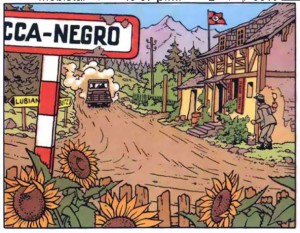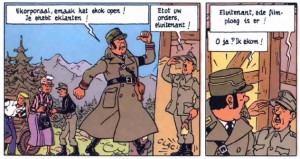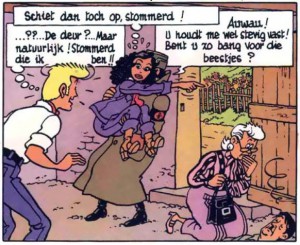In the 1976 Barelli album “Le seigneur de Gonobutz” (“The Lord of Gonobutz”) the military theme is omnipresent. The fact that Bob De Moor & Hergé just had finished the Tintin album “Tintin and the Picaros” isn’t really strange to that. Also in the album by Hergé the military is omnipresent. Whereas Hergé tackled the South-American regimes (left and right), Bob De Moor decided to loosely base his new Barelli album on Hergé‘s scenario for his very own take on dictatorships.

Just like in “Tintin and the Picaros”, “The Lord of Gonobutz” starts with an ‘involuntary invitation’ to another country (Barelli and his aunt are kidnapped to Rocca Negro by uncle Victorino) and just like in “Tintin and the Picaros”, “The Lord of Gonobutz” holds references to the Nazis.

In the Tintin story Colonel Sponsz, the former chief of the Bordurian secret police ZEP, is clearly etched on an SS-officer (although he is a member of a communist regime in “The Calculus Affair” he wears a uniform which reminds of that of the SS as designed by Hugo Boss) and in “The Lord of Gonobutz” we not only see a very Nazi-like flag being used but we also find out that none else but Adolf Hitler himself painting the wall of a house, which is a clear reference to Hitler’s first unsuccessful artistic career as a painter in Vienna, Austria.

Bob De Moor decided to put Hitler in quite a subordinate position (next to his chief Lieutenant Grimca) ridiculing him totally. And as icing on the cake, Barelli’s aunt Sophia even succeeds in smothering him with her weight as she jumps in his arms as a mouse appears. He doesn’t return to consciousness, at least not in the story.
This album is a must if you want to see how much the styles of Bob De Moor and Hergé were symbiotic. The album is stylistically excellent, although we’d have preferred a more worked out cover for the album itself. The story isn’t really meant to be taken serious and goes from joke to joke.
